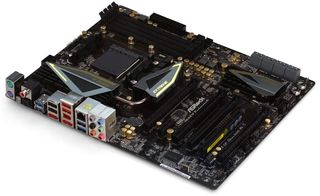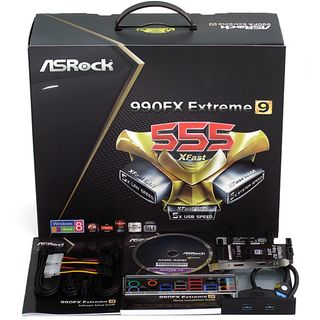Three AMD 990FX-Based Motherboards For Enthusiasts
AMD’s flagship FX-series processors squarely target enthusiasts with sub-$1,000 system budgets, and it's hard to get there with an expensive motherboard. We requested every vendor's top-value solution, and received three boards for your consideration.
ASRock 990FX Extreme9
We never thought we’d see one of ASRock’s high-end board at mid-budget prices, but the company surprised us by introducing the 990FX Extreme9 at $160. We thought this must surely be a mistake, but were assured that the price was real. It eventually climbed to $175, dropped to $160 just before this round-up, and is now priced at $190.
Update, 4/3: ASRock tells us that the 990FX Extreme9 is now listed for $160 again on Newegg. This price will be held until the end of April. For $30 less than this board was originally reviewed, its feature set becomes much more attractive, and more in-line with the value message of AMD's FX processors.

Based on its feature set, this board probably should be in the $175 range we saw it at a week ago. Its elaborate 14-phase voltage regulator, two added-on four-port USB 3.0 controllers, extra pair of two-port SATA 6Gb/s controllers, Intel PCIe-based Wi-Fi controller, and even the legacy IEEE-1394 controller seem a little out of place compared the two more mainstream products in today's story. Without question, this board is a premium part.
Four of those USB 3.0 ports and two of its SATA 6Gb/s ports feed rear-panel connectors, bounded by dual-format (coaxial and optical) digital audio connectors, six analog audio jacks, and a CLR_CMOS button.
The other two added-in SATA ports are exposed internally, next to the similarly-premium lighted power button, reset button, and two-digit LED diagnostics display. Doubling up on mid-market expectations, four USB 3.0 ports connect the two internal USB 3.0 headers, which ASRock pioneered at our request.

Keen observers might notice that the chokes on ASRock’s voltage regulator appear tiny; there isn’t much room behind the CPU socket for 14 phases. We're not certain whether ASRock’s 14 phases can out-power Asus’ eight, but as you already know, manufacturers tend toward a larger number of lower-capacity phases to pad spec sheets, even though that's no explicit indicator of power performance.
ASRock also adds an extra set of PCIe switches to its third x16-length slot, allowing the board's bottom slot to support eight lanes of second-gen PCIe. This could be viewed as mandatory by some buyers, since AMD's 990FX chipset doesn’t support PCIe 3.0. This potential boon to SLI flexibility is bolstered by a bundled three-way SLI bridge.
Stay On the Cutting Edge: Get the Tom's Hardware Newsletter
Join the experts who read Tom's Hardware for the inside track on enthusiast PC tech news — and have for over 25 years. We'll send breaking news and in-depth reviews of CPUs, GPUs, AI, maker hardware and more straight to your inbox.
We have no layout complaints and only a few caveats concerning 990FX Extreme9 connector placement. For example, all five fan headers are located near the motherboard’s top and bottom edges. All eight SATA ports point forward to a location that might be blocked by the drive cages of some (typically old) cases. The front-panel audio connector is placed in the traditional location, though the cables of some (typically old) cases are too short to reach its extreme bottom-rear corner. And because the board has two USB 3.0 dual-port internal headers, ASRock appears to think that two USB 2.0 headers are adequate. That last caveat is addressable via separately-available USB 2.0 adapters, when required.

Besides the already-mentioned three-way SLI bridge, the 990FX Extreme9 also include a two-way bridge, ASRock’s fantastic USB 3.0 drive bay adapter with integrated 2.5” drive tray and optional slot-plate, and an impressive collection of six SATA cables.
Current page: ASRock 990FX Extreme9
Prev Page Performance Beats Features? Next Page 990FX Extreme9 Software-
designasaurus "if we diminished most of those power differences by not installing Asus' power management software at default settings, the company would have likely matched the performance of Gigabyte and ASRock."Reply
Don't speculate! Do the tests and add it to the article so we can see what the software packages are actually accomplishing! That's why I read your site, yeah? For hard info that I can't get myself. -
bgunner designasaurus"if we diminished most of those power differences by not installing Asus' power management software at default settings, the company would have likely matched the performance of Gigabyte and ASRock."Don't speculate! Do the tests and add it to the article so we can see what the software packages are actually accomplishing! That's why I read your site, yeah? For hard info that I can't get myself.I totally agree with this statement. The test should have been done and added into the article because this would of been a good representative of the value of the software. I would like to know for a fact if the software was a hindrance to the electrical efficiency of the Asus and Gigabye boards.Reply -
Crashman bgunnerI totally agree with this statement. The test should have been done and added into the article because this would of been a good representative of the value of the software. I would like to know for a fact if the software was a hindrance to the electrical efficiency of the Asus and Gigabye boards.At least the power was measured and mentioned, even if it didn't get into the chart.Reply
-
bit_user AMD's 890FX was an excellent low-cost server platform, in its day. Great I/O, tons of PCIe lanes, 6-channel SATA3, and ECC support. All with boards and CPUs in the desktop price range that were close to being performance competitive with Intel (when they were introduced, at least).Reply
Now, AMD is just slipping too far behind. Not just on the CPU front, but like how about some PCIe 3?
I'm waiting for 64-bit ARMs to hit the desktop. That's probably the next truly interesting thing on the horizon.
-
boulbox Reply10596062 said:Aren't the 990FX chipsets kind old?
Yes, but not a lot of new things need to be offered anyways. PCIe 3.0 is just a gimmick and doesn't really give much more performance over PCIe2 -
Crashman falchardAren't the 990FX chipsets kind old?990FX is AMD's current "high-end" chipset for enthusiast-level desktops. AMD occasionally releases new chips (look last fall) and motherboard companies keep updating their selection of products.Reply
Old chipset, recent boards, any questions?
-
darkchazz "Three AMD 990FX-Based Motherboards For Enthusiasts"Reply
I don't think enthusiasts would want to buy a slow CPU from AMD. -
Onus What did I miss? The ASRock has better features, including 3-way SLI, more USB3.0, an abundance of accessories, uses less power (the only positive efficiency), has higher performance, lower VRM temps; but BOTH of the other two got awards? I noted the comment about fluctuating prices, but on features alone ASRock looks like the winner. Surely it wasn't the slightly lower OC...Reply
Most Popular




